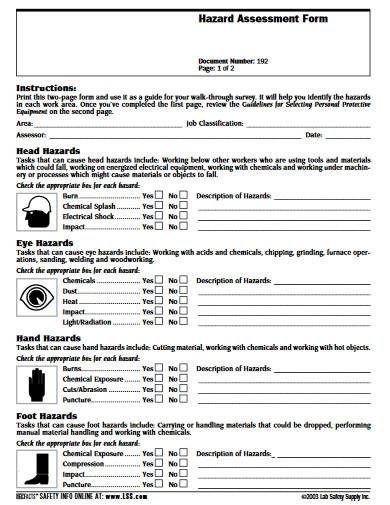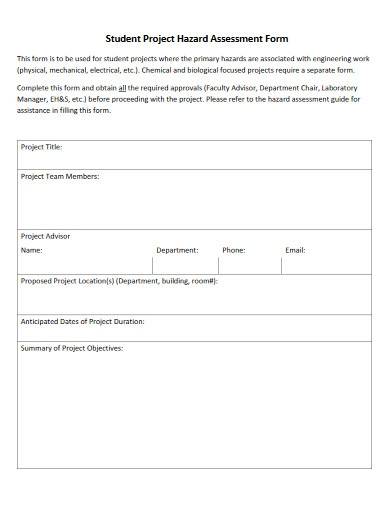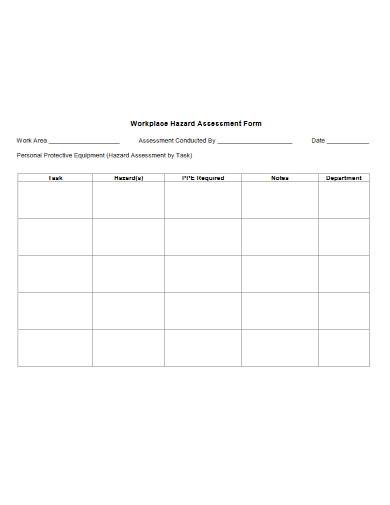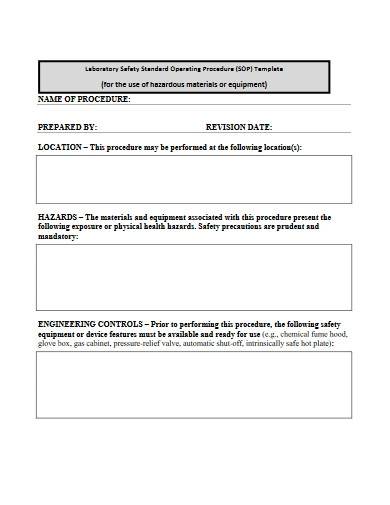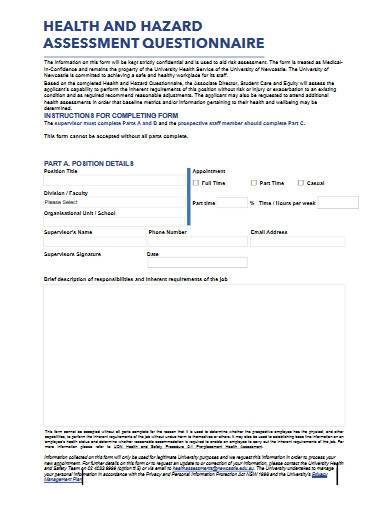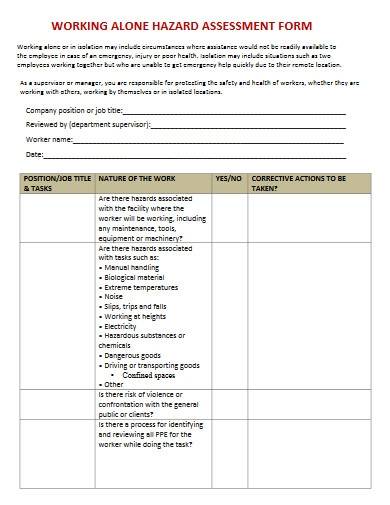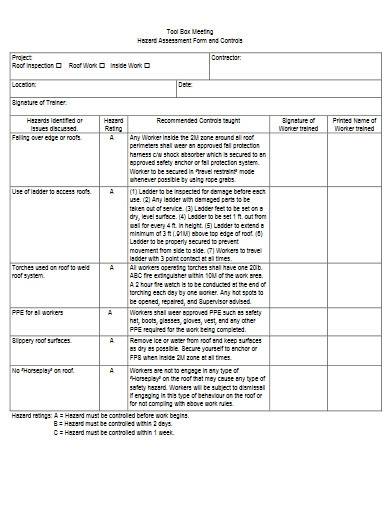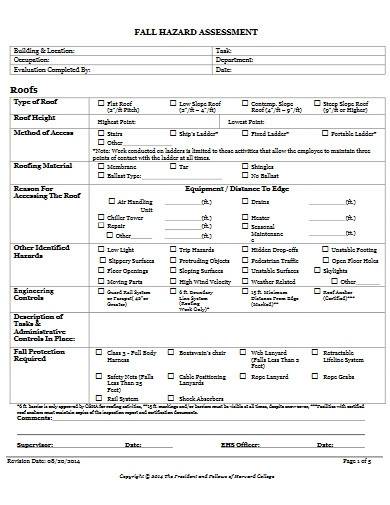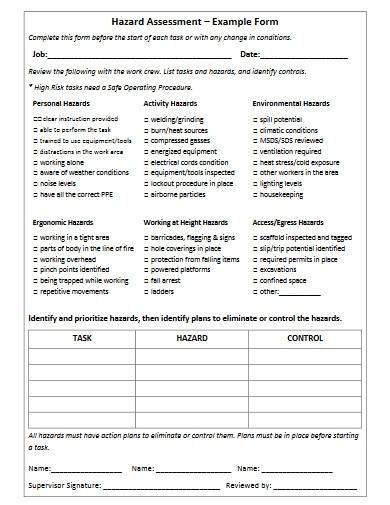Defining workplace risks is crucial to make sure the safety of workers and other stakeholders. This process is part of the hazard assessment in which it evaluates and does hazard controls to ensure the safety of the people working in the company. The challenge for you as an employer is how you would craft a hazard assessment? Luckily, we have shared our downloadable hazard assessment form template to help you get started. Keep scrolling and learn more about this topic below.
1. Hazard Assessment Form Template
2. Student Project Hazard Assessment Form
3. Workplace Hazard Assessment Form
4. Field Trip Hazard Assessment Form
5. Sample Hazard Assessment Form
6. Laboratory Hazard Assessment Form
7. Health & Hazard Assessment Questionnaire
8. Basic Hazard Assessment Form
9. Hazard Assessment Form Format
10. Fall Hazard Assessment Form
11. Simple Hazard Assessment Form
What Is a Hazard Assessment?
Hazard assessment is the method of identifying possible sources of harm or damage from performing a job task in a particular work environment. It is necessary to determine workplace hazards in order to uphold measures and control that will help guarantee the safety of employees and other stakeholders.
Usually, employers are the ones conducting the assessments. According to Health and Safety Executives, there are things that you need to do to determine hazards that are under the Management of Health and Safety of Work Regulations 1999. First, recognize what may cause injury or damage in your business, then assess how likely someone will be injured and how serious it is, and lastly, take steps to eliminate or monitor the danger. Hazard analysis is just one aspect of the overall process used in the workplace to manage risks.
What Is a Hazard Assessment Form?
A hazard identification test is a method used by safety officers in conducting hazard assessments, also known as a hazard assessment form. A hazard assessment’s primary aim is to define possible health and safety risks by evaluating occupational conditions or procedures. It is important to conduct regular hazard assessments and introduce adequate corrective steps that prevent accidents and diseases.
How to Effectively Perform a Hazard Assessment?
Assessing and identifying hazards or risks are not as easy as you might think. A hazard assessment decreases the risk of injuries happening in the workplace and guarantees the workers’ safety. Conduct risk assessments effectively by following the steps below:
Step 1: Look Around
The first thing that you must to identify any threats that may threaten your company and your employees’ safety is to look around your surroundings. Walk around the premises of your company and try to look for out-of-place items that may cause some problems and injury to your company and to your employees as well. Identify potential or existing things that are hazardous. Know how to recognize common workplace hazards.
Step 2: Think and Determine
After looking around your company’s premises and finally found some things that can threaten your security, assess the identified threats, and determine their underlying causes. Set and plan some appropriate steps to control such problems.
Step 3: Put Your Plan into Action
Once you already established and prepared the best measures to manage and remove threats on your company’s premises, put it into action. Needless to say, you have to execute all the plans and strategies in your mind that you think can control and secure your company and employee’s safety.
Step 4: Do a Regular Inspection
Hazard assessments do not end by implementing all the necessary measures. It should be best to conduct regular inspections and reviews. In this way, you can identify if it followed the standard operating procedures and safety control measures correctly. Also, this is the way to determine if your strategies are effective or not.
FAQs
What are the hazards and risks?
A hazard is a possible cause of harm or unfavorable health impact on a person or persons. The words hazard and risk are mostly used synonymously. However, both have a distinction. A hazard is something that would bring injury, such as electricity, chemicals, ladder work, noise, a keyboard, a workplace bully, tension, etc. A risk is a possibility that someone is potentially harmed by some threat.
What are the types of hazards?
There are a total of five hazards. A common way to classify and determine hazards is by categorizing them. The following are types of hazards:
- Biological hazards
Examples of biological hazards are bacteria, viruses, insects, plants, birds, animals, and humans.
- Chemical hazards
Examples of chemical hazards are the things that depend on the physical, chemical, and toxic properties of the chemical.
- Ergonomic hazards
Examples of ergonomic hazards are repetitive movements and improper set up of a working station.
- Physical hazards
Examples of physical hazards are radiation, temperature, magnetic fields, extremes, pressure extremes (high pressure or vacuum), and noise.
- Psychosocial hazards
Examples of psychosocial hazards are stress and violence.
- Safety hazards
Examples of safety hazards are slipping or tripping hazards, inappropriate machine guarding, and equipment malfunctions.
What are the types of hazard assessments?
There are two types of hazard assessments. They are formal and site-specific. Site-specific assessments are hazard assessments tailored to a specific site that provides only appropriate information for that particular project. On the other hand, formalized hazard assessments are hazard assessments that provide obligations and functions within a company.
Ensuring the safety and security of your company and employees are necessary. That is why it is best to conduct regular hazard inspections. In this way, you can avoid any threats and risks that can affect your business and workers. If you don’t know how to organize your assessments, our downloadable hazard assessment form templates can help you. Download our templates now and get started!
Related Posts
FREE 9+ Tutor Report Form Samples in MS Word | PDF
FREE 11+Incident Investigation Form Samples in PDF | DOC
FREE 10+ Retail Form Samples in PDF | MS Word
FREE 10+ Customer Enquiry Form Samples in PDF | MS Word
FREE 10+ Customer Maintenance Form Samples in PDF
FREE 10+ Expense Reimbursement Form Samples in PDF | DOC | Excel
FREE 7+ Distributor Assessment Form Samples in PDF | MS Word
FREE 10+ Legal Client Intake Form Samples in PDF | MS Word
FREE 4+ Child Custody Form Samples in PDF | MS Word
FREE 10+ Mileage Reimbursement Request Form Samples in PDF | MS Word
FREE 10+ Transcript Order Form Samples in PDF | MS Word
FREE 9+ Juror Information Form Samples in PDF | MS Word
FREE 10+ Employee Absence Record Samples in PDF | MS Word
FREE 9+ Sample Consumer Contracts Model Cancellation Forms in PDF
FREE 16+ Construction Form Samples in PDF | MS Word

